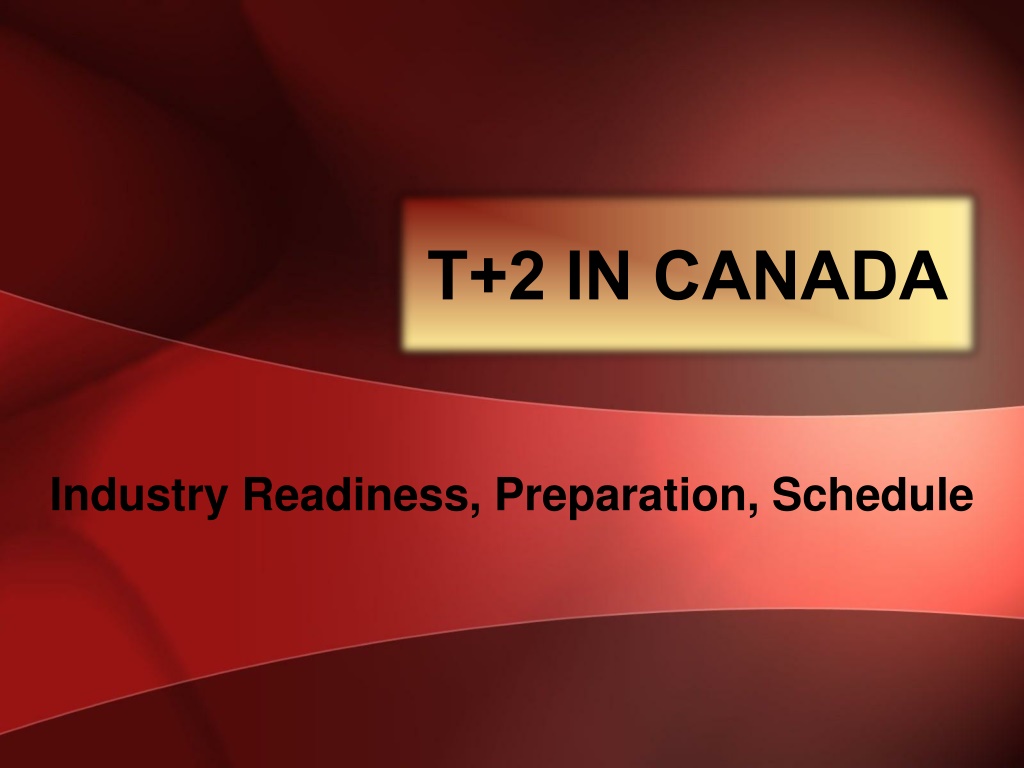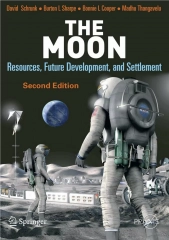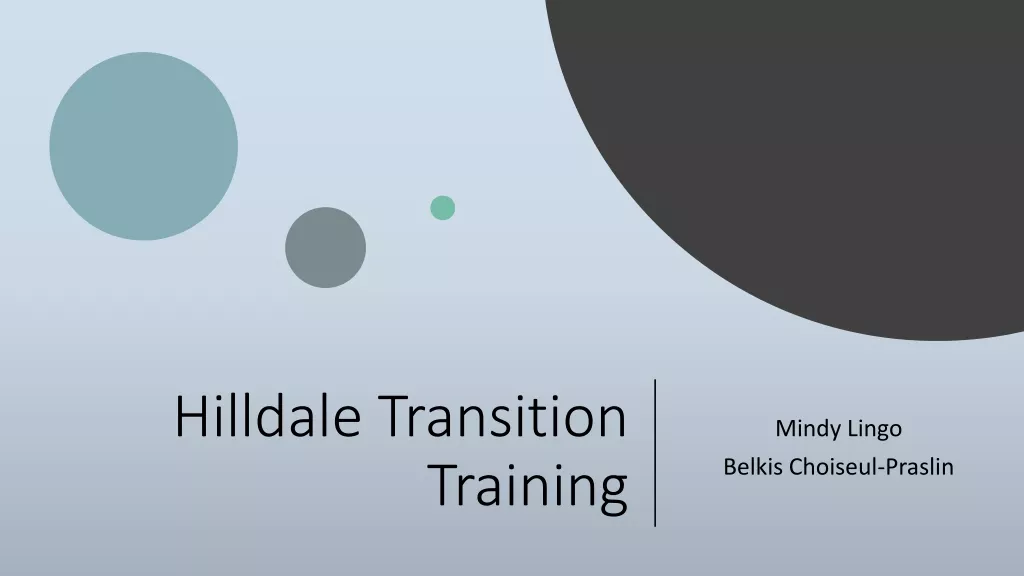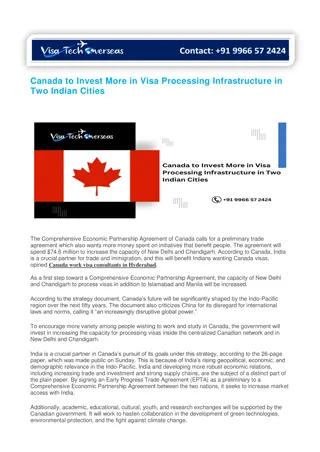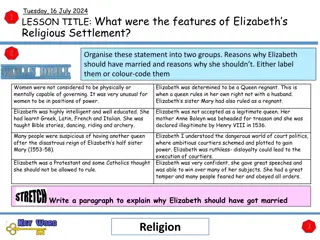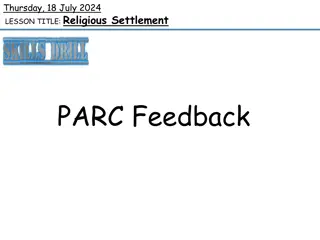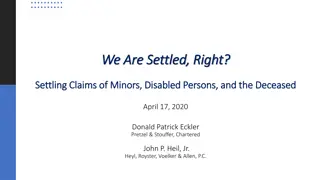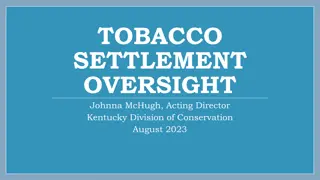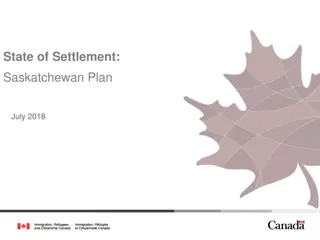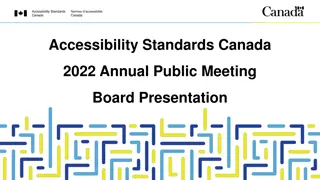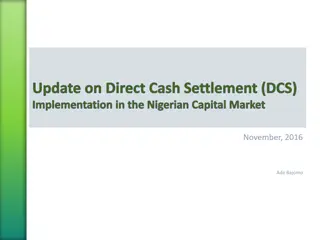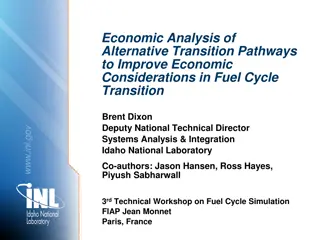Understanding Canada's Transition to T+2 Settlement Cycle
Canada is moving from a T+3 to a T+2 settlement cycle, reducing counterparty risk and enhancing global settlement harmonization. This transition aligns with moves in other markets and involves key stakeholders like the Canadian Capital Markets Association (CCMA). The shift aims to provide more efficiency and safety for investors.
- Canada
- T+2 Settlement Cycle
- Canadian Capital Markets Association
- Counterparty Risk
- Global Settlement
Download Presentation

Please find below an Image/Link to download the presentation.
The content on the website is provided AS IS for your information and personal use only. It may not be sold, licensed, or shared on other websites without obtaining consent from the author. Download presentation by click this link. If you encounter any issues during the download, it is possible that the publisher has removed the file from their server.
E N D
Presentation Transcript
T+2 IN CANADA Industry Readiness, Preparation, Schedule
Agenda What is T+2/Canada s Move to T+2 T+2 Stakeholders Products Affected by T+2 T+2 Timeline T+2 Preparedness Considerations Custodians Buy side/investment and mutual fund managers Sell side/dealers Summary
What is T+2? T+0, T+1, T+2, T+3 refers to days to settle following trade execution T+2 = trade date + 2 days T+2 = Short-hand for industry-wide initiative led by CCMA to condense maximum standard trade-to- settlement cycle from T+3 to T+2
Canadas Move to T+2 Benefits Reduced counterparty risk Risk that a party to a trade fails to deliver cash or a security is one day less Increased global settlement harmonization Expected decreased margin, liquidity, clearing capital requirements More efficient, safer, better service for institutional and retail investors
Canadas Move to T+2 Other Markets T+2 in 2017 T+2 pre-2016 T+2 March 2016
Canadas Move to T+2 North America U.S. announced transitioning to T+2 in 2017 Practically, Canada must change on same day April 2015: Canadian Securities Administrators (CSA) fully support Canada s move (Staff Notice 24-312) Substantial cross-border activities: Canada must align to U.S. schedule Follows Europe s move to T+2 in Oct. 2014 and Australia/New Zealand move in March 2016 Endorses CCMA to co-ordinate
Canadas T+2 Stakeholders CCMA CCMA = Canadian Capital Markets Association Launched 1999; communicates, educates, helps co-ordinate cross-capital-markets projects Initial projects were: T+1 STP (straight-through processing) National Instrument (NI) 24-101 Moth-balled in 2008 Small board (CBA, CDS, IIROC, TMX) Today s priority: T+2
Canadas T+2 Stakeholders Other Associations (IFIC, IIAC, ACPM, CBA, others) Major infrastructure Canadian Depository for Securities Fundserv Exchanges, alternative trading system Service bureaus, back-office providers, vendors Custodians Buyside: Investment managers, portfolio managers Sell-side: IIROC, MFDA, exempt market dealers
Products Affected by T+2 High Level T+2 for all assets currently settling on T+3 standard Equities Corporate and long-tem government bonds Mutual funds Not affected T-bills already settle as quickly as same-day (T) Money market mutual funds and options (T+1) Short-term federal government bonds (T+2) New issues, special terms , not regular way
Products Affected by T+2 Details CCMA Canadian T+2 Asset List Final version posted on www.ccma-acmc.ca Sections for securities that are traded (capital markets/exchange) or bought/redeemed (funds) U.S. Asset T+2 List Similar assets, revision to list in T+2 Playbook underway Visit www.ust2.com/
T+2 Timeline Canada/U.S. Schedule U.S. and Canadian schedules align U.S. CANADA Oct. 2012: DTCC-commissioned BCG report showed positive benefit-to-cost ratio from shortening settlement cycle Apr. 2014: All major U.S. industry organizations commit to move to T+2 June 2015: Updated U.S. T+2 white paper; all major U.S. industry organizations commit to move to T+2 Dec. 2015: Industry proposal to SEC Jan. 2008: CSA NI 24-101, Institutional Trade Matching and Settlement, required reporting to regulators if less than 90% of North- American trades matched by noon on T+1 July 15, 2015: CCMA re-activated for T+2 Sept. 2015: CDS white paper on T+2 issued Dec. 2015: CCMA relaunched and staffed; milestones ready; industry awareness builds 2016/Q1 2017: CDS and key infrastructure to develop, test systems changes and finish cross-industry test plan; firms start changes Q1-Q3 2017: Firms build, Canadian industry testing, confirmation of readiness Sept. 5, 2017: Implementation 2016: DTCC and key infrastructure to develop, test systems changes, develop test plans; firms start changes Q1-Q3 2017: Firms finish changes; U.S. industry testing; readiness confirmed
T+2 Timeline Canada Late Summer 2016 Requests for comments issued by regulators Year- end 2016 Target: finish builds Spring/ Summer 2017 Industry utility test environ- ments open Summer 2016 Sept. 5, 2017 Fall 2016 Detailed industry-wide test plans issued by CDS, Fundserv, and U.S. Replies to regulatory consulta- tions due Go live! Go/ No Go Decision Formality 4-6 weeks pre-Sept. 5
T+2 Timeline How to interpret Understand implementation date has two parts: Sept. 5: first day trades made for T+2 settlement Sept. 7: last day trades settle T+3, first settle T+2
T+2 Preparedness How ready? First step: look at timing of trades entered and matched Entered T Entered Noon T+1 Entered T+1 EOD Matched T Matched Noon T+1 Matched T+1 EOD Trades June 07 52% 76% 84% 23% 55% N/A Dec. 09 71% 90% 94% 45% 85% 90% Dec. 11 78% 92% 95% 50% 87% 92% Dec. 13 79% 89% 92% 50% 88% 92% 95% 94% Dec. 15 81% 97% 54% 90% Improved 07 to 15 56% 25% 15% 135% 64% N/A Worry about these 5% and 6%!
T+2 Preparedness Key issues Utilities, service bureaus, vendors expect to be ready 100+ issues identified by industry members Two primary issues Readiness what does it mean? Will buy side be ready? (it s dispersed, no single association) Testing what kind of testing will be sufficient? Mandatory? Scripted? Certified? See www.ccma-acmc.ca, Committees for issue lists
Considerations General Map all current downstream and upstream processes to find steps to reduce or accelerate Review impact on reports, files and databases Make changes to trading, portfolio valuation, cash management, other systems Make changes to reports, prospectuses, contracts Check suppliers are T+2-aware, will be ready, tested Consider impacts on institutional and retail clients Penalties? Stay on top of industry T+2 efforts
Considerations Custodians Essentially ready: largest have flexibility to deal globally, especially with Europe s move to T+2 Current efforts focus: Work with buy side to identify processing flaws Eliminate securities processing redundancy, increase efficiency support to meet NI 24-101 NI 24-101 expected to require matching of at least 90% of ALL trades by volume and value by noon on T+1 Get the word out inform clients about T+2
Considerations Buy Side/Managers Learn lessons from Europe, Australia, New Zealand Engage senior management Assign corporate-wide project status and monitor Leverage U.S. Playbook Explore whether current irritants will become showstoppers due to shorter timelines Holiday processing International client allocations/communications Get involved directly or through your association(s); sign up for free CCMA newsletter, notices
Considerations Buy Side/Managers Portfolio management Misaligned cycles may create funding shortfall Cost of credit to cover mismatches at transition How will move to T+2 affect cash management Policy Retail clients, private clients, institutional Segregated cash flow timing Pooled fund subscriptions and redemptions Seg accounts bad impact borne by client pooled funds must meet best interests of all
Considerations Buy Side/Managers Operations Less time to notify of/receive corrections from sub-advisors in different time zones Less time to fix mistakes, direct FX movements, Less time to recall lent securities Less time for designated brokers to manage ETF unit creation and redemption Check accrued interest calculations, implications re corporate actions, dividends Work with custodians, broker/dealers, service providers and vendors
Considerations Buy Side/Mutual Funds Mutual fund and segregated fund companies, distinct from IIROC or MFDA dealers in funds Segregated funds not securities but follow standard settlement cycle for mutual funds Fundserv links manufacturers and distributors Minor impact on Fundserv Standards, systems Key issues are: Approach to testing v27 (June) + T+2 overlap ID ing which funds are changing should be all
Considerations Sell Side/Dealers Trade reconciliations reduced timelines Holiday processing International client allocations/communications Physical securities Key infrastructure: CDS (see CDS White Paper) Service bureaus and back-office providers (Broadridge, IBM, IFDS, NBCN, intermediaries) Vendors
Summary Canadian markets must go to T+2 same day as U.S. Firms must cut steps and/or compress processes Most agree systems will be minimally impacted Canadian firms and marketplace well-positioned to meet September 5, 2017 date Don t let this lull you into false sense of security Biggest issue likely behavioural CCMA ED Keith Evans part of UST2 Command Centre confirming Go/No Go mid-/end-July 2017 Stay informed and participate!
Information Sources & Questions ww.ccma-acmc.ca FAQs updated periodically Newsletter sign up for free T+2 Readiness Self-Assessment Checklist T+2 Asset List Industry survey results Investment manager checklist Testing information www.ust2.com Playbook Testing updates and other tools
